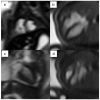The New Frontiers of Fetal Imaging: MRI Insights into Cardiovascular and Thoracic Structures
- PMID: 39200740
- PMCID: PMC11354430
- DOI: 10.3390/jcm13164598
The New Frontiers of Fetal Imaging: MRI Insights into Cardiovascular and Thoracic Structures
Abstract
Fetal magnetic resonance imaging (fMRI) represents a second-line imaging modality that provides multiparametric and multiplanar views that are crucial for confirming diagnoses, detecting associated pathologies, and resolving inconclusive ultrasound findings. The introduction of high-field magnets and new imaging sequences has expanded MRI's role in pregnancy management. Recent innovations in ECG-gating techniques have revolutionized the prenatal evaluation of congenital heart disease by synchronizing imaging with the fetal heartbeat, thus addressing traditional challenges in cardiac imaging. Fetal cardiac MRI (fCMR) is particularly valuable for assessing congenital heart diseases, especially when ultrasound is limited by poor imaging conditions. fCMR allows for detailed anatomical and functional evaluation of the heart and great vessels and is also useful for diagnosing additional anomalies and analyzing blood flow patterns, which can aid in understanding abnormal fetal brain growth and placental perfusion. This review emphasizes fMRI's potential in evaluating cardiac and thoracic structures, including various gating techniques like metric optimized gating, self-gating, and Doppler ultrasound gating. The review also covers the use of static and cine images for structural and functional assessments and discusses advanced techniques like 4D-flow MRI and T1 or T2 mapping for comprehensive flow quantification and tissue characterization.
Keywords: 4D flow images; congenital chest pathologies; congenital heart disease; fetal cardiac gating; fetal cardiac magnetic resonance; fetal magnetic resonance.
Conflict of interest statement
The authors declare no conflicts of interest.
Figures








References
-
- Ercolani G., Capuani S., Antonelli A., Camilli A., Ciulla S., Petrillo R., Satta S., Grimm R., Giancotti A., Ricci P., et al. IntraVoxel Incoherent Motion (IVIM) MRI of Fetal Lung and Kidney: Can the Perfusion Fraction Be a Marker of Normal Pulmonary and Renal Maturation? Eur. J. Radiol. 2021;139:109726. doi: 10.1016/j.ejrad.2021.109726. - DOI - PubMed
-
- Capuani S., Guerreri M., Antonelli A., Bernardo S., Porpora M.G., Giancotti A., Catalano C., Manganaro L. Diffusion and Perfusion Quantified by Magnetic Resonance Imaging Are Markers of Human Placenta Development in Normal Pregnancy. Placenta. 2017;58:33–39. doi: 10.1016/j.placenta.2017.08.003. - DOI - PubMed
-
- Antonelli A., Capuani S., Ercolani G., Dolciami M., Ciulla S., Celli V., Kuehn B., Piccioni M.G., Giancotti A., Porpora M.G., et al. Human Placental Microperfusion and Microstructural Assessment by Intra-Voxel Incoherent Motion MRI for Discriminating Intrauterine Growth Restriction: A Pilot Study. J. Matern. Fetal Neonatal Med. 2024;35:9667–9674. doi: 10.1080/14767058.2022.2050365. - DOI - PubMed
Publication types
LinkOut - more resources
Full Text Sources

